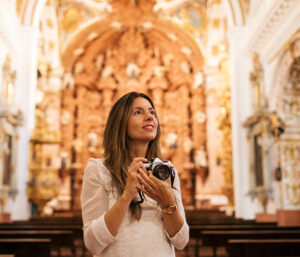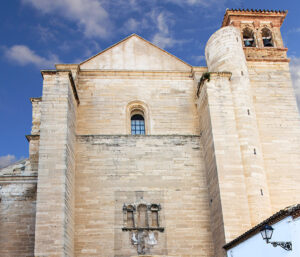We find a simple façade, whose most significant element is its mannerist façade. This consists of a semicircular arch, marked by two Tuscan half-columns on plinths, crowning the entire curved and split pediment, which appears centered with a shield of Carmel. To the right of this cover is a small belfry, with a single hole, the only remnant of the bell tower after the demolition, in 1883, of the so-called Torre del Gallo.

The whole of the plan of this church follows, with some variants, the model of Granada Moorish church, with a single nave, spatially very well defined main chapel and side chapels totally independent of each other. In addition, in the eighteenth century, was added, at the foot of the church, the nave of the Brotherhood of Solitude, conceived as another chapel. The important Mudejar coffered ceiling that covers the entire space of the nave, completed in 1614, is rectangular and without wooden straps, which allows, logically, greater visibility.
Its bow decoration is completely decorated by a swarm of laceries, which are only interrupted by three pineapples of mocárabes. The main chapel, is configured in its interior space as a large rectangular prism crowned with half sphere. But what accentuates the lamajestuosity of this main chapel are its three huge altarpieces, particularly the central or larger, built in the years before 1747. This presents very dilated proportions and is considered, for its beauty and significance, as one of the most interesting examples of the Andalusian baroque altarpiece of the eighteenth century.
Its complicated articulation of stipes, cornices, niches, simulated curtains …, all traced with very broken mixtilinear profiles, which curve and inflect in an endless game, produces a first impact of obfuscation. This huge machine was conceived as a Carmelite hymn, in which the saints related to the order are accompanied by a whole court of adolescent and small angels, who already play musical instruments, already hold cartouches or garlands, or simply, join their hands in graceful attitudes, which seem to touch palms. It is surprising to think that all this immense baroque contraption is nothing but the frame that serves as the mouth of the central dressing room, in which the image of the Virgen del Carmen is kept. In relation to the dressing room we must not forget its interest as a well-articulated architectural space.

Its mixtilinear and very baroque plant, contrasts, to some extent, with the sobriety of its plasterwork decoration and its cleaning of lines. The two collateral altarpieces of this main chapel, despite being finished in their gilding and polychromy, we believe that they are somewhat more modern than the largest. St. Elijah, on the Gospel side, is particularly bulky because of the complexity of the attic. The altarpiece and the dressing room on the side of the Epistle is the most fully rococo of the three, also presenting more harmonious proportions.
In the main arch of the main chapel is located the pulpit of gilded and polychrome wood. This piece, which is signed by Miguel Márquez García, was made in 1799 and in its baroque lines and spirit harmonizes perfectly with the altarpieces described. Six independent chapels open to the central nave, which present pieces of great value inside. The chapel or nave of Solitude, located at the foot of the church, must have been built in the first third of the eighteenth century, at which time the curly plasterwork of the cupulita belongs. The chapel has a rectangular floor plan and is covered with vaults of half barrel lowered and divided into four sections by arches fajones.
The main altarpiece, occupies in its central niche, as a very small dressing room, the image of the Virgin of Solitude. Occupying a modern niche, located in the arch of access to the chapel, the primitive image of the Virgen del Socorro, made in the late fifteenth century and given by the Catholic Monarchs to the church-mosque of San Salvador, is exposed with a certain museum sense. Technically it is made of cardboard paste and mounted on a wooden structure, preserving the primitive polychromy in part.
Contact:
Address: Plaza del Carmen, Antequera, Málaga
Schedule:
Tuesday to Friday: 11:00 h to 13:30 h / 16:30 h to 18:00 h
Saturday and Sunday: 11:00 h to 14:00 h
Phone: 952739662
